The Obelisks of Egypt: The myths of their construction and erection explored
INTRODUCTION
In April of 2015 I had the opportunity to visit Egypt during which time I viewed the Unfinished Obelisk in Aswan and the two Obelisks at Karnak which are the topic of this paper. I am an architectural technician who for fifty years has been figuring out how to build the Architect’s designs; thus, when looking at the Obelisks, the question arose – how did they construct and erect these amazing structures. I make no claim to be an “expert” but only that I approach everything with an open and enquiring mind, a beginner’s mind open to all possibilities.
POINT OF REFERENCE
While in Luxor I purchased a book entitled The Obelisks of Egypt by Labib Hamachi (1984, The American University in Cairo Press), which is used as a point of reference with regards to the “conventional” Egyptology view of how the Obelisks were constructed and erected. References to this publication are shown in italics in the text without further reference.
THE UNFINISHED OBELISK
The Unfinished Obelisk, if finished, would have been 41.75 meters tall with a base of 4.2 meters on each side and a weight of 1168 tons. The quarry it is situated in is located in Aswan (24.076886°, 32.895361°), and is 1053 meters in a north-west direction to the present day edge of the Nile River. The geography of the area is mainly granite so it may be assumed that the course of the Nile has change little over the passage of time in this area.

We are told that “Work started by removing the uneven surface. This was accomplished by placing bricks upon the surface to be removed, heating them until they were quite hot, and then dousing them with cold water. The rock surface fractured and became easily detachable, rendering the surface reasonably smooth.”
and the experts in Egyptology claim that the obelisk was cut from the granite bedrock by using
“Large balls of dolerite, each weighing about 5.5 kilograms and measuring 15 to 30 centimeters, were found near the obelisk . . . The balls were apparently attached to rammers and were used by being struck vertically downward with great force.”
and state that
“The trench and pits were therefore not cut out, but rather bashed out.”
and that
“Several thousand men can be imagined arranged about the obelisk in groups of three, two standing, holding and raising the rammer, and the third squatting and directing the blow to the proper place.”

Let us examine each of these points.
There is nothing reasonable about the explanation of clearing the uneven surface. With the sheer size of the site, how do you heat them to a hot enough temperature and with what? Then they must be transported. And how much water would it take to cool them? There would be no control over the fracturing, and remember we are dealing with granite which is a very hard stone.
The dolerite rocks existing on the site are of random size and shape, these would have had to be attached to a “ramming pole” (this is assumed), of what size or length is unknown. The granite is then smashed with these stones. In the name of accurate science, has anyone ever tried to duplicate this procedure and determined how much granite would be eroded in the course of an eight hour day under the sun and temperature that is prevalent in Aswan?
Because of the randomness of the stone and the procedure described, the cavities obtained would be irregular, as would the breaking of the granite. There would be no control over the shape or direction.
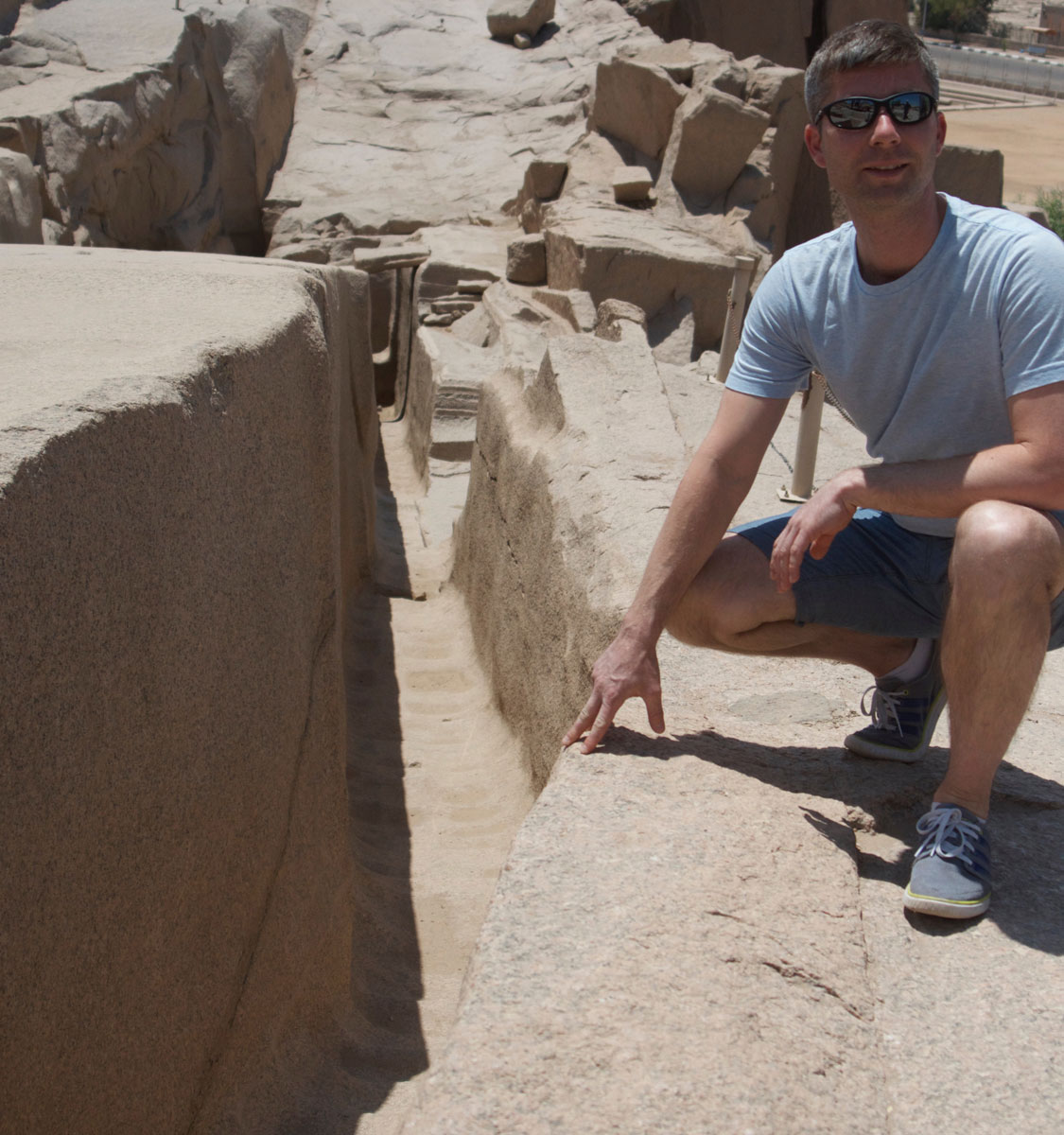
If we view the excavated sides of the Unfinished Obelisk we will note the uniformity in their cuts and shape: the walls are vertical, the width of the cut in the attached photo is approximately 50cm wide – it is uniform and straight. The sides show no sign of being “bashed”.

The sides of the cuts show vertical ridge lines at a regular spacing, the face between these ridge lines in nearly flat and the ridges themselves are minimal in height. At the bottom of the cut there is a radius. Note that there is no concave hole which would be the result of “bashing” with the dolerite rocks. These cuts appear to be approximately 20 to 25 cm wide and consistent in their verticality and width.
None of this suggests “bashing” by random stones but instead suggests something making a series of vertical cuts into the granite. What would have made these cuts is speculation but the evidence points directly to some other technology, perhaps a cylindrical revolving cutter.
Several thousand men can be imagined arranged about the obelisk in groups of three: two standing, and the third squatting and directing the blow to its proper place.
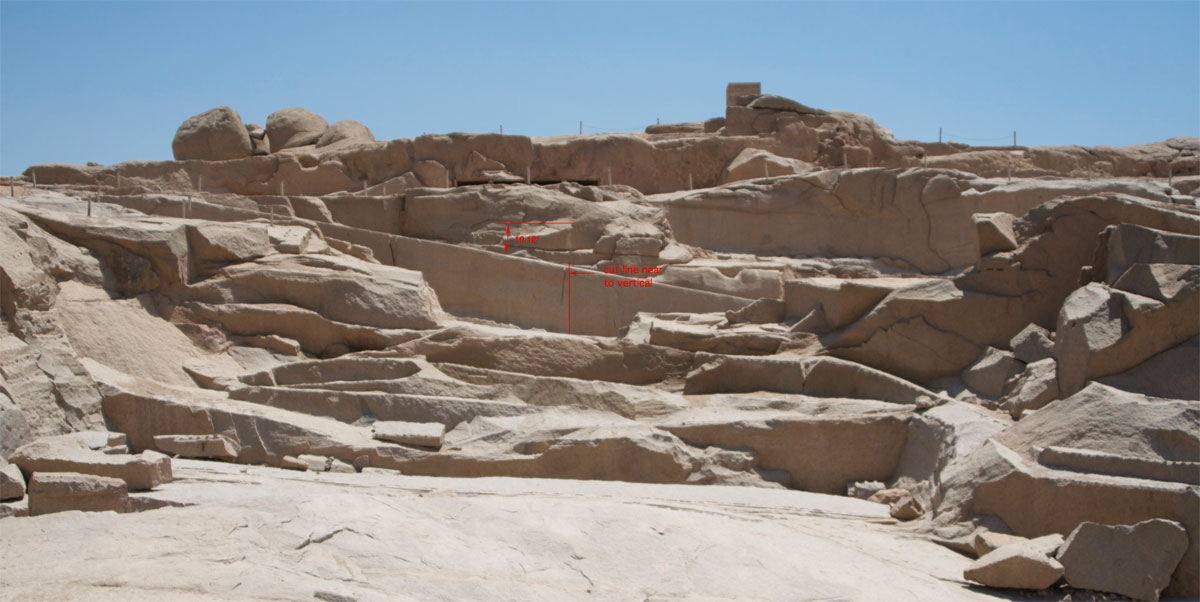
One would certainly have an imagination to visualize that. The Building Code in Canada states that for standing space each person takes up 0.40 square meters. How many is “several thousand”? Let’s assume 2500, meaning they would require 1000 m2 without any space for maneuvering.
Note the irregularity of the site, note that the cut lines are vertical to the horizon not to the obelisk itself, and also note that the obelisk lies on a slope of 10° to the horizontal.

It would be physically impossible to have several hundred, let alone several thousand, men situated around the obelisk and performing the work function that has been suggested by the Egyptology “Experts”.
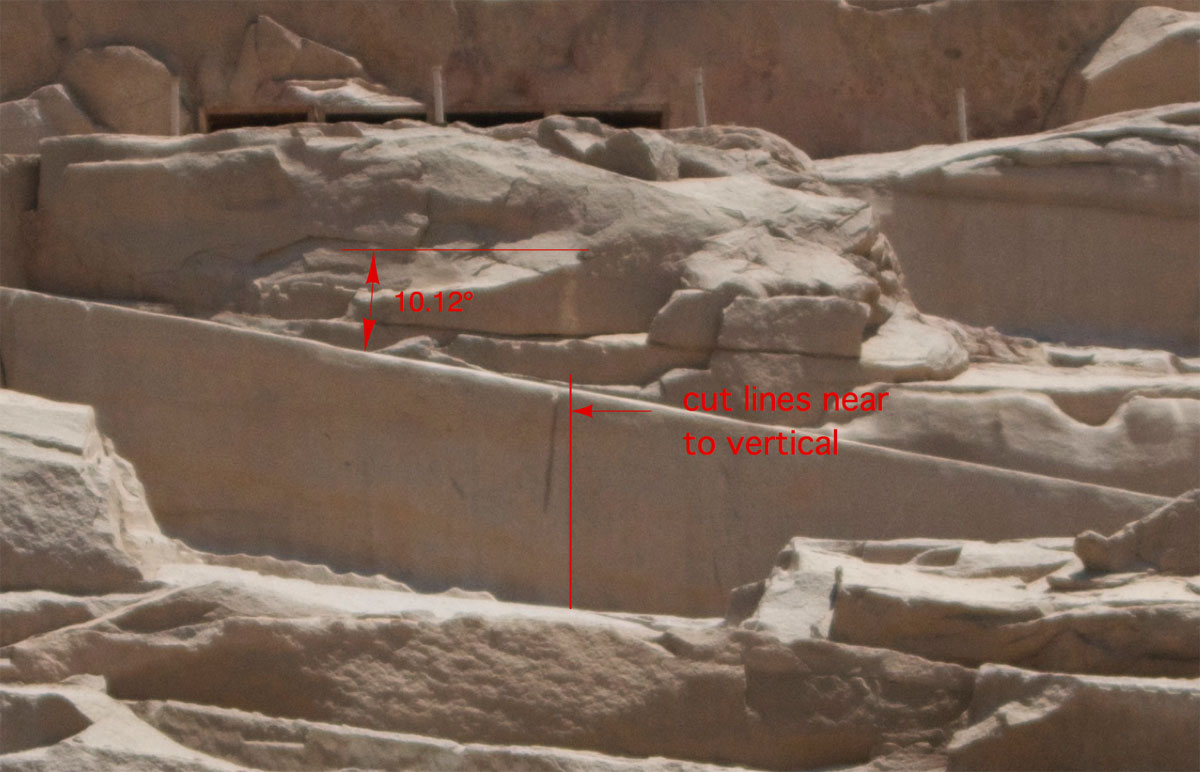
We are then told:
Had the Unfinished Obelisk proved flawless, the lower side would have been detached from the parent rock by pounding. Galleries would have been driven underneath and progressively filled with planks of wood until the side was completely detached.
By using these levers from both sides of the obelisk in turn, it could be made to rock slightly backwards and forwards and gradually raised by increasing the height of the packing below each heave. By this means, the base could be raised some 2.43 meters above its present level, and the quantity of rock to be removed in front of the obelisk greatly reduced in consequence.
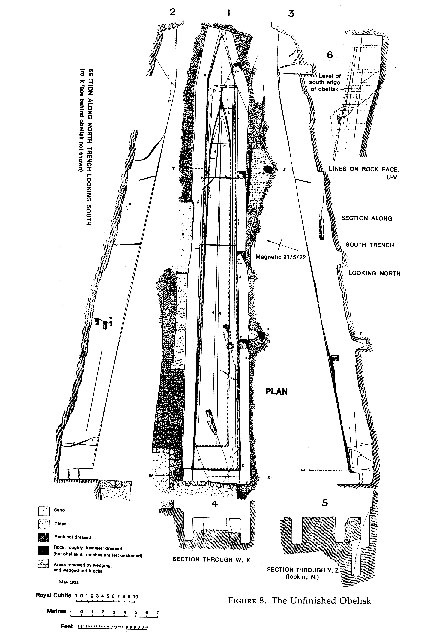
Having undertook the quarrying of and object of such dimension and size, those responsible would have had the means to remove and transport the obelisk. It should be noted at this point that the obelisk lies on a 10° slope to the horizontal. As previously noted the side cuts vary is size but the minimum appears to be approximately 50cm in width. For three men with their pounding instrument to work in this space would be impossible, let alone underneath the obelisk removing debris and inserting wooden blocks. Once totally detached and sitting on its wooden blocks the obelisk would be free to then slide to the lowest point in the pit.
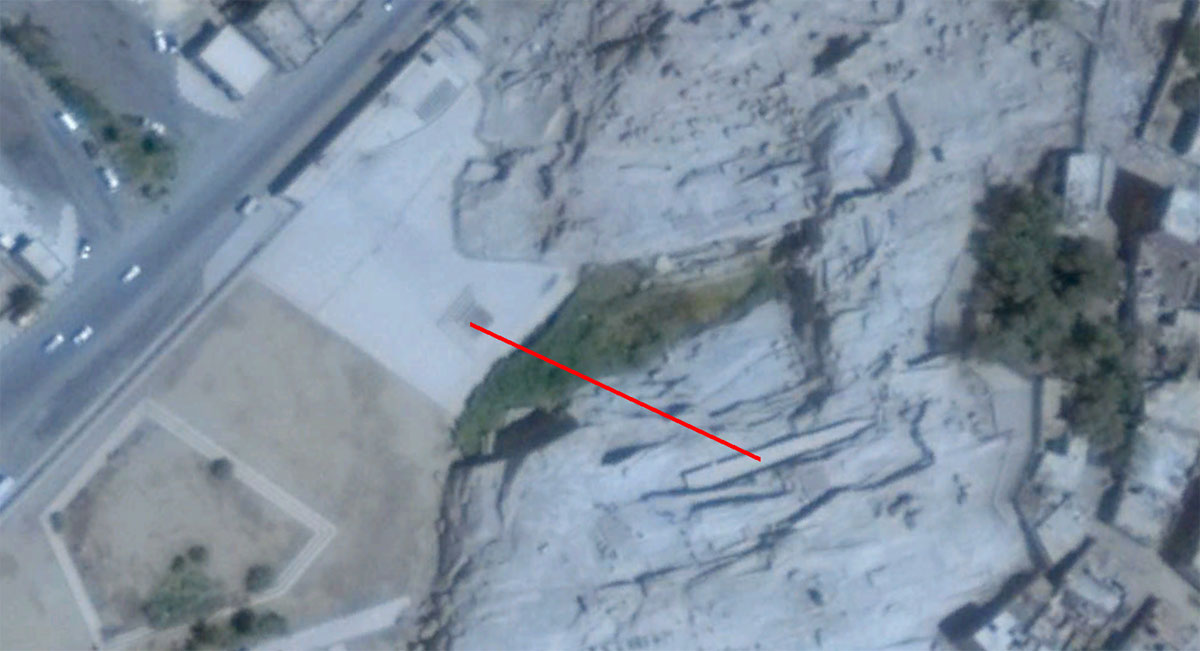
We are then to believe that timbers or logs were inserted to rock the obelisk to enable it to be raised. Just looking at the photos of its location one can see the impossibility of such a task, there is no room to insert levers let alone push the down. We are talking about an object that weighs 1168 tons (2,336,000 lbs)1. Even if it was possible having once raised and leveled it, the obelisk would be in the order of 6 meters above the adjacent level surface and would have had to have been moved approximately 65 meters to that area, 1168 tons. This raises some questions: Where did all the wood come from? If not physically able to insert levers how was it raised? Once raised how was it moved and then lowered to the level of the adjacent area?
We would be talking about an immense construction project made of wood just to accomplish such a task and in an area where trees of any sizeable dimension do not exist.
Again another unknown technology is most likely the answer.
When the obelisk had been raised high enough and a path cleared, it would be dragged down the slope to the river. English archaeologist Reginald Englebach calculated that this could be done by 6,000 men pulling 40 ropes, each 18.4 cm (7.25”) in diameter.
It is suggested that other obelisks were placed on a sledge or on rollers to be dragged.
First let us examined the number of men and the amount of rope: 6,000 men on 40 ropes equals 150 men per rope occupying a space of 1 meter each, equals a rope 150 meters plus long by 18.4 cm in diameter. What would the weight of the rope be alone? Try to grip an object that is 18.4 cm in diameter then imagine having to pull on that. Then how do you attach said ropes to the obelisk? They could not be wrapped around it because they would interfere with the rollers. This assumes that each man is capable of pulling 340 lbs (154kg), not including the weight of the rope. It assumes that there are 6,000 able-bodied men available to do this in the heat of the day.
[The ropes: imagine making one rope 18.4 cm in diameter and 150 plus meters in length. You can not tie knots with a rope like that, how would you attach it to the obelisk? then imagine making 40 of them and transporting them to the site, lifting and moving them. This can only be called a English flight of fantasy.]
Now the rollers would have to be of sufficient diameter and consistency in size to accommodate such a weight. They would most likely be 6 meters in length; where did all of these come from? Over a length of 40 meters would require at least 40 of them plus those to be put in front as it moves along. For the rollers to work they would all have to be straight and of the same diameter. How would this be achieved and from what source would they come?
The surface leading down to the river would have to be relatively smooth and free of obstacles, also relatively constant in slope and the fact that it would be down hill to the river. How do you hold back a 1168 ton object on rollers on a downhill slope? It would be similar to retaining a loaded freight truck on a hill with no brakes. This is assuming a straight course, which would be unlikely, so how would you turn this on a downhill without brakes?
When examining the conventional view in detail to this point one can only assume some very good imaginations at work. Imaginations that deny the physical evidence, such is the nature of Egyptology “experts”.
I do not have the answer for “how it was done” but do know that it was not as presented in “The Obelisks of Egypt” and other online sources.
Whoever undertook this project knew things and technologies that have long been forgotten.
We would be hard pressed to duplicate such a venture today with our current technologies let alone attempting to duplicate those that have been described.
We are then told that the obelisk was to be loaded on to some kind of boat and transported down the Nile to its final location. I will deal with the subject of this part of the journey in a separate paper addressing all the possibilities and impossibilities of such a venture.
THE OBELISKS OF KARNAK
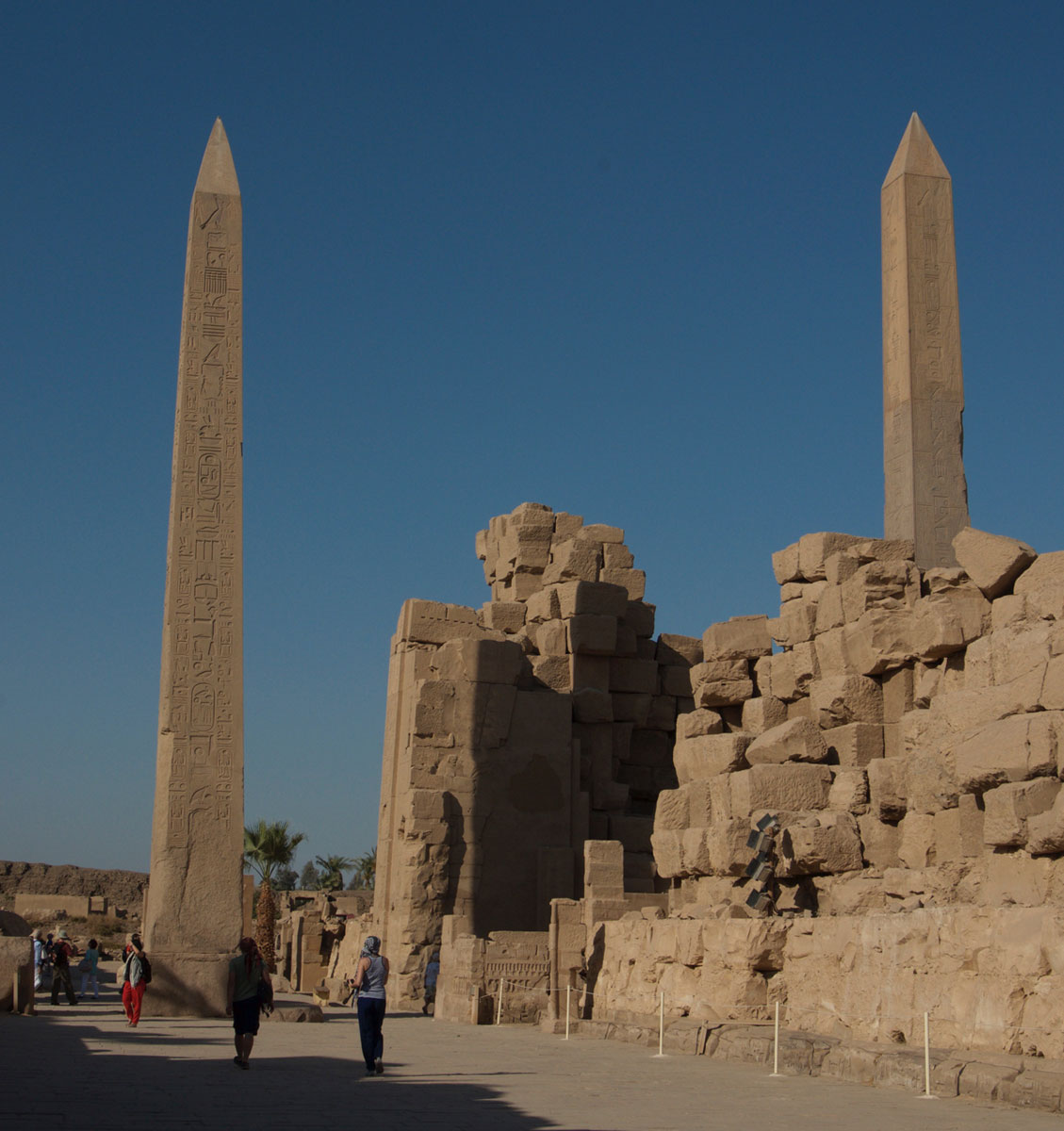
Tuthmosis I on the left, Hatshepsut on the right
There are two obelisks at the Karnak Temple site that remain standing. The first of these is said to be one of a pair that were erected by Tuthmosis I, the third king of the Eighteenth Dynasty (reign 1506–1493 BC (disputed)), they were made of red granite and the remaining one is 19.5 meters tall and is estimated to weigh 143 tons (286,000 lbs).
The second one is one of four obelisk erected by Hatshepsut (reign 1473–1458 BC); it too is made of red granite and stands 29.5 meters tall and weighs and estimated 323 tons (646,000 lbs).
Both of these stand on their own stone bases.
Having transported the obelisks to the site let us explore the way in which they are said to be erected.
A ramp of earth or sand had to be extended from the point of debarkation to the place where the obelisks were to stand. The obelisks were then dragged to that location and the task of erecting them begun. The opinions of engineers, architects, and archaeologists of how this was accomplished vary considerably, and a number of different schemes have been suggested . . . Engelbach suggests the following:
“A method which is mechanically possible and which meets all observed facts is that the obelisk was not let down over the edge of which is an embankment, but down a funnel shaped pit in the end of it, the lowering being done by removing sand, with which the pit had been filled, from galleries leading into the bottom of it, and so allowing the obelisk to settle slowly down. Taking this as the basis of the method, the form of the pit resolves itself into a tapering square-sectioned funnel – rather like a petrol funnel – flair wide at the top, but very little larger than the base of the obelisk at the bottom. The obelisk is introduced into the funnel on a curved way leading gradually from the surface of the embankment until it engages smoothly with the hither wall of the funnel. The sand is removed by men with baskets through galleries leading from the bottom of the tunnel to convenient places outside of the embankment.”
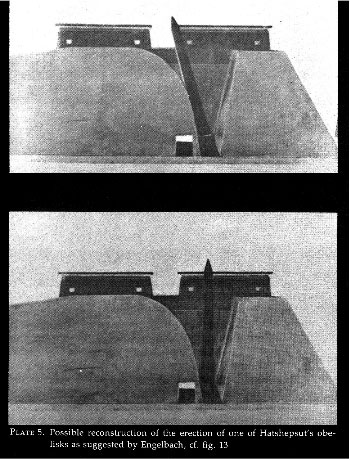
First let us address the type of material that could possibly be used for such an enterprise. Sand: dry sand would be unusable, it could not be compacted to support the load suggest plus all of the foot traffic of those “thousands” of men who are going to pull it up the ramp. The curved shape of the “funnel” and the close to vertical slope on the right hand side would be impossible to achieve with sand and how would you maintain the shape of the “funnel”? There would be nothing to cause the sand or earthen material to hold its shape.
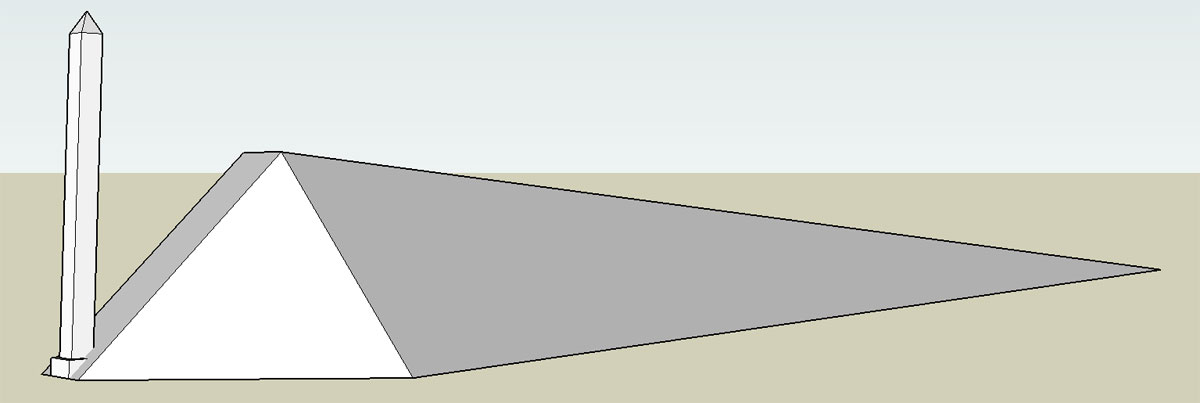
When piled earth or sand will form a maximum 45° slope, the maximum slope for the ramp would be 10%, anything higher would be extremely hard to pull up. Assuming the ramp would have to reach a height of 20 meters before the obelisk is lower over the edge, the ramp would be a minimum of 210 meters in length and contain 37,250 m³ of material as shown above.

The ramp itself would have to be at least 6 meters wide to accommodate the obelisk and the “thousands” of men required to pull and push it up the ramp. How do you physically get that many men in place there? There would come a point where they would no longer be able to pull, so how do you push it the remaining distance? Once it had reached the tipping point at the top of the ramp, which would be crumbling under the shear weight of the obelisk, it would then just fall over onto the 45° slope. Any sand there would be crushed and disbursed. The only way a “funnel” could occur would be if a structure made of stone or wood were to be built around the base but even then having it filled with sand which is removed through galleries would be extremely difficult and still there would be no control as the obelisk slid into the cavity. Every last bit of sand between the obelisk and its base would have to be remove otherwise the sand would act like ball bearings under the obelisk causing it to possibly slide.

Another version of this has the obelisk reaching that tipping point then being pulled up to its erect position by ropes. But where would these have been affixed? And how?
It is assumed that some if not all of the surrounding structures could have been in place prior to the obelisk being erected. If so, and given the immensity of the ramp, how would this been accomplished in the confined space that existed at the time? Just to construct one of these ramps would have been a major undertaking and we are told that there were six obelisks. Where did this mass of material come from? How was it placed? How could it possibly hold its shape to support 323 tons or more? How could the men possibly maneuver on such a structure and push and pull the ramp on rollers? We are told it took seven months to create the obelisk; how long would it take to construct the ramp, move the obelisk, and remove the ramp or relocate it for the next obelisk?
There are two other considerations with regards to this scheme. The first is that existing structures were in place in the area in which Hatshepsut’s obelisk was placed as is shown on Karnak Digital Time Map (http://dlib.etc.ucla.edu/projects/Karnak/timemap) which would conflict with the above described ramp.
The second consideration is the amount of force required to move the 323 ton obelisk up the ramp, Because of the incline, the amount of force is increased over that required on level ground. My mathematical skills are not such that I am able to determine this according to the equation below, but it can be assumed that it would be impossible to gather enough men on the ramp to accomplish such a task.

Let us not forget also the problem of attaching ropes to the obelisk so that the “thousands” of men could move it. And one final point: as the obelisk were to slide over the edge of the ramp in contact with whatever material the ramp was composed of, there would be a high probability that abrasion would occur to that face of the obelisk, a face that had received a high degree of finishing.
THE OBELISK by HATSHEPSUT
Now we will look at the obelisk which has stood in place for almost 3,500 years, which is 29.5 meters (96’-9”) tall and … square2 at its base. It sits on a rock base which is …3 in size. This base would have to sit on rock-solid stone so that there would be no differential settlement. The top of the base would have to be dead flat, level and virtually smooth. It could have no debris (sand or earth) on it when the obelisk was put in place.
The bottom of the obelisk would likewise have to be dead flat, level and virtually smooth. It would also have to be at a perfect right angle (90°) to the center line of the obelisk itself. The slightest difference in this angle would cause a lean in the obelisk which increases as it ascends. Likewise all four sides need to be symmetrical about the center line of the obelisk. If one side were greater than the others it would cause an offset in the center of gravity. Therefore, after being roughly hewn from the quarry, it would have undergone a precision shaping and finishing prior to the inscriptions being applied and it being erected. It is hard to believe that this precision shaping was done with men with wooden mallets and copper chisels or dolerite rocks, or polished with sand or crushed rocks. The edges are perfectly square with very little roundness. This is precision. The tolerances for erecting a stone of this size along with the possibility of it fracturing would have required a very high degree of control. For it to have been placed so precisely and to have stood the test of time, and continue to do so, speaks of unimaginable skill. Will any of our modern day structures be around 3,500 years from now? I somehow doubt it.
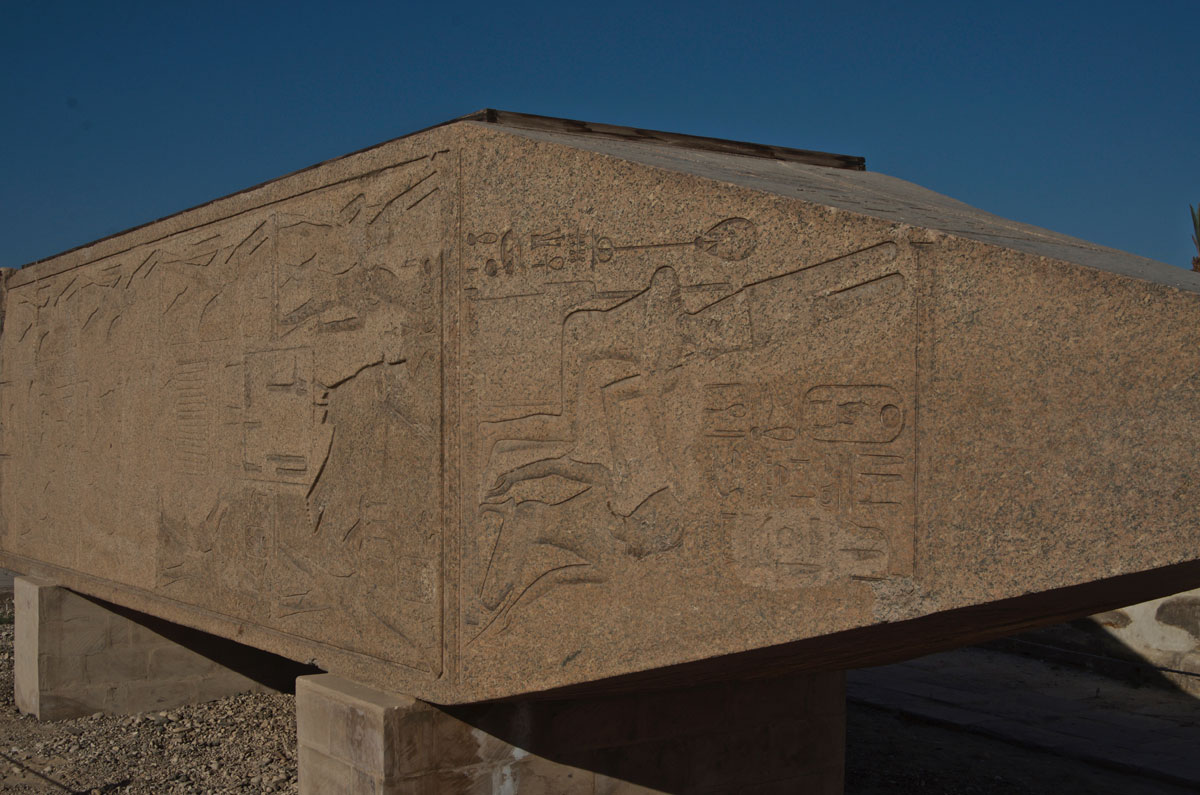
The engravings are precise; there are suggestions as to the tools that were used but none really satisfy when standing in the presence of this amazing work. Just look at the precision of the cuts, the straightness of the lines over the length of the stone; there is no chance for error, you cannot put the material back after it is removed. How would we do this today? Christopher Dunn suggests that a vibratory sonic cutting process would be more suitable where the tool plunges into the material to a prescribed depth.4 There is also evidence of rectangular tools having been used.
We are told by Egyptologists of great learning what all these inscriptions mean; but do we really know, or are they just making educated guess and assumptions as is the case for how the obelisks were made and erected?
On the base of her obelisk that still stands in Karnak, Hatshepsut recorded that
“she made as her monument for her father Amun, Lord of the Two Lands dwelling in Karnak, the making for him of two great obelisks of solid red granite of the region of the south; their upper haves gold of the best of all countries.”

The inscription above was found on the south face of the Obelisk, erected by Hatshepsut. How do you get such a precise English (or any other language) interpretation from something like the above? I would suggest that it might take a large amount of guessing and wishful thinking to describe, but then of course the people that do this are “experts” not to be questioned. Is it not possible that the symbols might have multiple meanings depending upon the context they are used in or have totally different meanings than those we choose to assign to them? Just as our “experts” have assumed that they know how the obelisks were created, transported and erected, and that this should not be questioned, maybe the same incorrect assumptions are being made in the translations.
CONCLUSION
We are looking at an amazing culture that communicated with symbols, that did amazing things with stone which have lasted centuries and yet we describe them as being somewhat primitive in comparison to our “modern” ways. Does the evidence not suggest something far more advanced – knowledge that has been lost in the passage of time? The obelisks are just one example of the great mystery that stands before us, we can choose to stay stuck in our conventional beliefs or we can embrace the mystery and continue to question it and search for answers.
Having stood in wonder in front of these and the other amazing artifacts of passed civilizations, one cannot help but question their origins and the current stories we are told about them. Some greater technologies are at play here, lost to us and our modern ways. What they are is the mystery, but as long as we hold to the conventional view as put forth by the “experts” we shall never find the answer to the mysteries. We must be willing to question and to believe in the impossible because if we don’t how do we ever expect it to happen?
1 a standard North American railway boxcar loaded weighs 70-100 tons
2 the writer was unable to source these dimensions
3 the writer was unable to source these dimensions
4 The Lost Technologies of Ancient Egypt, Christopher Dunn.




